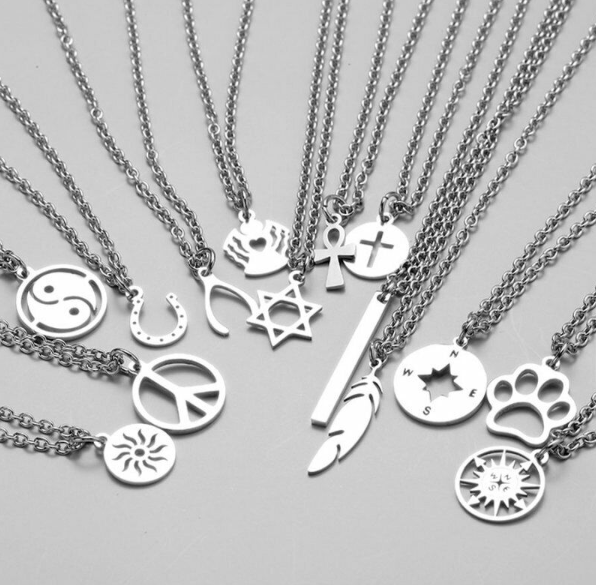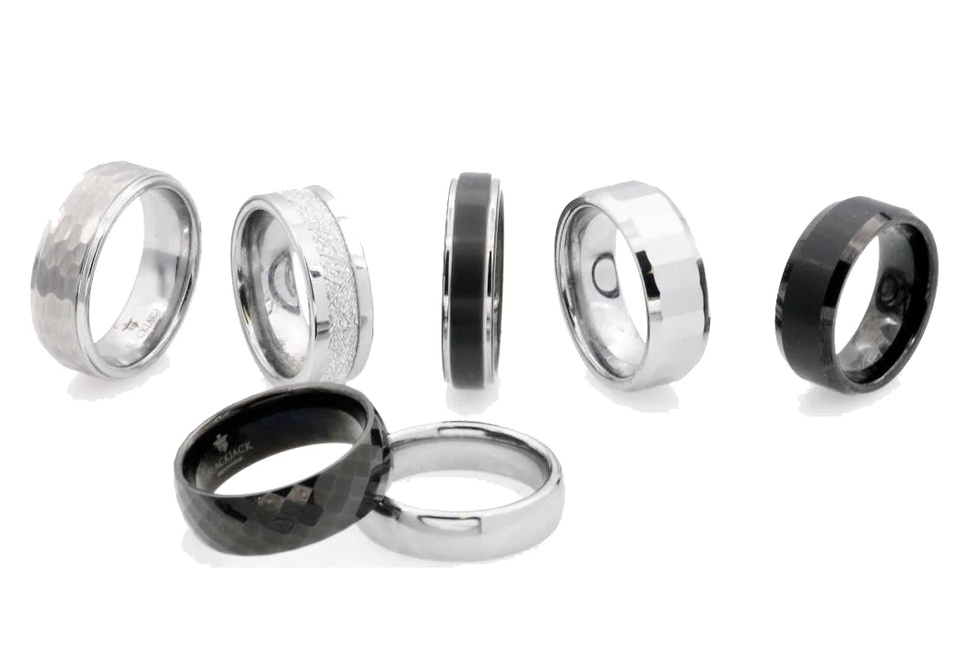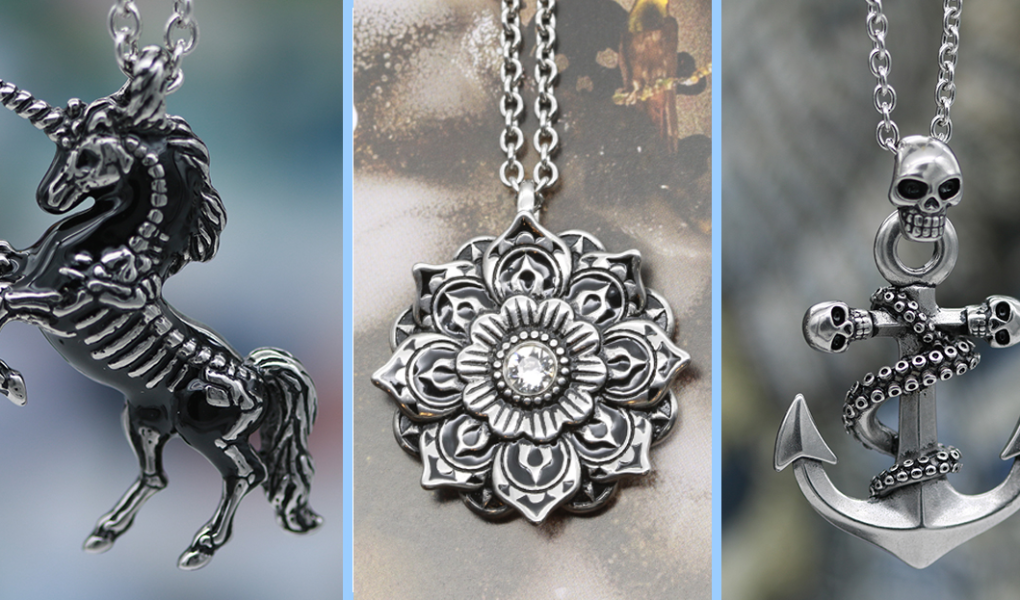Stainless steel, a versatile and resilient material, has gained significant prominence in the jewelry industry in recent years.
Its emergence as a preferred choice for crafting exquisite jewelry has sparked curiosity and debate among consumers and industry experts.
In this exploration, we briefly overview stainless steel as a material in the jewelry industry and answer the burning question: Is stainless steel jewelry good?
Once considered primarily for industrial applications, stainless steel has transcended its utilitarian roots to become a formidable contender in jewelry design.
Its remarkable qualities, including durability, corrosion resistance, affordability, and a lustrous finish, have positioned it as an attractive alternative to traditional precious metals like gold, silver, and platinum.
However, whether stainless steel jewelry is a worthy investment and an ideal choice for adornment depends on various factors that we will delve into in this discussion.
Composition and Properties of Stainless Steel
Stainless steel, a remarkable material frequently utilized in the jewelry industry, owes its exceptional qualities to a well-balanced blend of alloy components, primarily iron, chromium, and often nickel and molybdenum.
These components work in synergy to imbue stainless steel with unique characteristics that make it a standout choice for crafting jewelry.
Basic alloy components (iron, chromium, and often nickel, molybdenum)
Iron is at the heart of stainless steel’s composition, providing the material with its structural integrity and robustness.
What truly distinguishes stainless steel, however, is the incorporation of chromium into its alloy mix. Chromium, in varying percentages, forms a protective layer on the surface of stainless steel, known as a passive film.
This passive film is the secret behind stainless steel’s remarkable resistance to corrosion.
Furthermore, nickel and molybdenum are often added to enhance specific properties, such as further corrosion resistance and increased strength.
Anti-corrosive properties
One of the most celebrated features of stainless steel is its inherent resistance to corrosion, a property that significantly appeals to jewelry designers and wearers alike.
The chromium-rich passive film protects the underlying metal from succumbing to rust or staining, even when exposed to moisture, chemicals, or the rigors of daily wear.
This corrosion resistance is essential for maintaining the long-lasting beauty of stainless steel jewelry, ensuring it remains tarnish-free and retains its shine over time.
Durability and strength
Stainless steel’s durability and strength are equally noteworthy attributes. Thanks to its robust composition, stainless steel jewelry can endure the wear and tear of everyday life without losing its structural integrity.
This resilience ensures that your jewelry remains in excellent condition for years, making it an ideal choice for pieces meant to be cherished and passed down through generations.
Additionally, stainless steel boasts an impressive strength-to-weight ratio, allowing for intricate and delicate jewelry designs that can withstand time.
Benefits of Stainless Steel Jewelry
One of the standout benefits of stainless steel jewelry is its hypoallergenic nature. For individuals with sensitive skin or allergies to certain metals, stainless steel is a welcome relief.
Unlike some metals, stainless steel is less likely to cause allergic reactions, making it a comfortable and accessible choice for a wide range of wearers.
Hypoallergenic Qualities
The enduring durability and remarkable longevity of stainless steel jewelry deserve closer examination.
The primary factor behind these attributes is stainless steel’s innate resistance to tarnishing and rust. Unlike many other metals, stainless steel creates a protective layer of chromium oxide on its surface, which acts as an impenetrable shield against the corrosive effects of oxygen and moisture.
This layer effectively prevents tarnishing, discoloration, and rusting, ensuring that your jewelry remains impeccable, even when subjected to various environmental challenges.
Whether you wear your stainless steel pieces in humid climates, during intense physical activities, or in everyday life, they retain their original shine and allure.
This resilience is especially valuable for those who seek jewelry that can withstand the rigors of daily wear and exposure to the elements.
Durability and Longevity
Stainless steel jewelry’s enduring beauty unveils a remarkable tale of resilience and longevity, setting itself apart as a symbol of timeless elegance.
Its story of durability begins with a secret shield – a virtually invisible yet formidable guardian in the form of a chromium oxide layer.
This armor-like layer, a natural byproduct of stainless steel’s composition, stands vigilant against the relentless forces of tarnish and rust, unrivaled in its ability to repel their advances.
It acts as a silent sentinel, ensuring that your cherished jewelry remains unsullied even when exposed to the whims of the elements, retaining its unblemished allure in defiance of time’s passage.
Stainless steel’s defiance of environmental challenges is nothing short of remarkable.
From the humid embrace of tropical climes to the tumultuous adventures of an active lifestyle, it remains unwavering, steadfastly protecting its inherent brilliance.
Each piece of stainless steel jewelry is a testament to a material that doesn’t just survive; it thrives amidst the rigors of everyday life.
Whether you wear it while conquering mountains, navigating bustling city streets, or simply in the rhythm of daily existence, your stainless steel jewelry remains an emblem of timeless beauty.
Affordability
In jewelry, stainless steel is a beacon of affordability that doesn’t compromise quality or style.
Compared to traditional precious metals like gold or silver, stainless steel jewelry emerges as an inviting doorway to adornment, beckoning budget-conscious individuals to explore the realm of elegance without the weighty financial burden.
Its cost-effectiveness is a testament to inclusivity, making the beauty of well-crafted jewelry accessible to all.
What truly distinguishes stainless steel is its ability to offer a high-end aesthetic experience without the accompanying premium price tag.
Its polished surfaces glisten with a luxurious allure that rivals more expensive metals, while its adaptability in design allows artisans to fashion captivating pieces that embody sophistication.

Versatility in Design
Stainless steel’s remarkable versatility in jewelry design is a testament to its adaptability and creative potential.
Its malleability allows it to be molded into a broad spectrum of styles, catering to jewelry enthusiasts’ varied tastes and preferences.
Whether you gravitate towards the understated elegance of sleek, minimalistic designs or are drawn to the elaborate beauty of intricate and ornate pieces, stainless steel can effortlessly embody these aesthetics.
This adaptability ensures that stainless steel jewelry appeals to a broad audience, from those who appreciate the simplicity of a timeless piece to those who seek the luxury of intricate, finely detailed jewelry.
Furthermore, stainless steel’s capacity to harmoniously blend with other materials is a game-changer in jewelry design.
Low Maintenance
Preserving the enduring beauty of stainless steel jewelry is an effortless endeavor, making it a particularly appealing choice for those leading fast-paced lives.
The low-maintenance nature of stainless steel jewelry is a valuable advantage for individuals with busy schedules, as it requires minimal attention to retain its luster.
Caring for stainless steel is a straightforward process that involves little time and effort, allowing you to enjoy your jewelry without the burden of extensive upkeep.
The basic routine involves a gentle wipe with a soft cloth to keep your stainless steel jewelry pristine.
This simple action effortlessly removes fingerprints, smudges, and everyday dirt, restoring the piece to its original brilliance.
This quick cleaning ritual is ideal for busy individuals, as it can be conveniently incorporated into daily wear routines without causing disruption.
Drawbacks and Considerations
While stainless steel jewelry offers many advantages, it’s essential to consider some drawbacks and factors that might influence your decision when choosing this material for your adornments.
These considerations provide a well-rounded perspective on the suitability of stainless steel in jewelry.
Heaviness
While celebrated for its durability and resilience, stainless steel jewelry carries the trade-off of being slightly heavier compared to some alternative materials. This added weight can be a matter of personal preference and comfort.
Some appreciate the heft of stainless steel jewelry, finding it reassuring and substantial. It imparts a sense of durability and sturdiness that aligns with the material’s robust reputation.
However, for those who prefer lightweight adornments or have concerns about jewelry-induced strain on their ears, neck, or wrists during extended wear, the weight of stainless steel might pose a minor drawback.
This is especially pertinent for earrings, necklaces, or bracelets, where the cumulative weight of multiple components can become a consideration.
Limited Resale Value
A key consideration in stainless steel jewelry is its relatively limited resale value. Unlike precious metals such as gold or silver, stainless steel jewelry lacks the inherent monetary worth that often appreciates over time.
Its value is primarily tied to its aesthetic and functional attributes rather than its rarity or preciousness.
Consequently, stainless steel jewelry is not a significant long-term investment, and its resale potential is usually limited. This aspect should be remembered by individuals who view their jewelry as potential assets for future financial gains.
While stainless steel jewelry offers immense value in style, durability, and affordability, it may provide different financial returns than traditional precious metals.
Therefore, when choosing stainless steel jewelry, one should prioritize personal enjoyment and style over potential future resale value.
Potential for Scratches
While stainless steel is renowned for its durability, it’s essential to acknowledge its susceptibility to scratches under specific conditions.
Despite its remarkable resistance to corrosion and tarnish, stainless steel can develop minor surface scratches or scuffs over time. These imperfections are more likely to occur when stainless steel jewelry comes into contact with abrasive surfaces or harsh chemicals.
For individuals who expect their jewelry to maintain an immaculate appearance throughout its lifespan, the potential for scratches can be a notable drawback.
However, it’s worth noting that minor scratches on stainless steel can often be mitigated through polishing or refinishing, restoring the jewelry to its original sheen.
This maintenance requirement is relatively straightforward but may be a consideration for those who prefer jewelry materials less prone to surface damage.
Variability in Quality
The quality of stainless steel jewelry can exhibit significant variability, dependent on factors such as the grade of stainless steel used and the craftsmanship involved in its creation.
To ensure you receive a stainless steel jewelry piece that lives up to the material’s full potential in terms of durability, shine, and resistance to tarnishing, it’s crucial to purchase from reputable sellers and designers.
High-quality stainless steel jewelry adheres to specific industry standards regarding its composition and finish. These standards guarantee that the jewelry retains its integrity and aesthetics over time.
Conversely, lower-quality stainless steel may possess a different level of durability or resistance to tarnish, potentially leading to premature wear or loss of luster.
Thus, the importance of purchasing stainless steel jewelry from trusted sources must be balanced, as it ensures that you receive a piece that embodies the material’s best attributes while minimizing potential drawbacks.

How to Care for Stainless Steel Jewelry
Stainless steel jewelry, known for its durability and enduring beauty, requires minimal maintenance to keep it looking its best.
Proper care ensures that your pieces remain lustrous and pristine, maintaining their appeal over time. In this guide, we will explore effective cleaning techniques and provide valuable tips for preserving the brilliance of your stainless steel jewelry.
Cleaning techniques and tips
Effective cleaning techniques and practical tips are vital in preserving the allure and longevity of various items.
Whether caring for cherished possessions, maintaining personal hygiene, or tidying up living spaces, having the right cleaning methods and insights at our disposal can make a significant difference.
- Gentle Wipe with a Soft Cloth: The simplest and most frequent cleaning method for stainless steel jewelry involves using a soft, lint-free cloth. Regularly wipe your jewelry with this cloth to remove fingerprints, smudges, or surface dust. This routine maintenance helps maintain the jewelry’s shine and minimizes the need for more intensive cleaning.
- Mild Soap and Water: Prepare a gentle cleaning solution using mild dish soap and warm water for a deeper clean. Dip a soft-bristle toothbrush or a lint-free cloth into the soapy water and gently scrub the jewelry’s surface. Pay attention to any intricate or detailed areas. Rinse the jewelry thoroughly under running water to remove all soap residues.
- Pat Dry: After cleaning, always ensure your stainless steel jewelry is completely dry. Use a clean cloth to pat it down or air dry it. Avoid using paper towels or abrasive materials that could scratch the surface.
- Stainless Steel Cleaner: You can use a specialized stainless steel cleaner for stubborn stains or if your jewelry has lost some of its luster. Follow the manufacturer’s instructions carefully, and always rinse and dry your jewelry afterward.
- Avoid Harsh Chemicals: Stainless steel is generally chemical resistant, but it’s wise to avoid exposing your jewelry to harsh chemicals, such as bleach or ammonia. These substances can dull the shine or damage the protective layer of the stainless steel.
- Separate Storage: When not wearing your stainless steel jewelry, store it separately from other pieces to prevent scratches. You can use soft pouches or jewelry boxes with individual compartments to keep them safe.
- Regular Inspection: Inspect your jewelry for signs of wear or damage, such as loose stones or clasps. Address any issues promptly to prevent further damage.
- Polishing: Stainless steel jewelry may benefit from occasional polishing to restore shine. Use a specialized stainless steel polishing cloth, which can be found at most jewelry stores or online retailers. Gently buff the jewelry’s surface to bring back its luster.
Storing to prevent scratches and damage
Stainless steel jewelry, celebrated for its robustness and timeless appeal, requires careful consideration for storage.
While stainless steel is highly resistant to tarnishing and corrosion, it is not entirely impervious to scratches or damage.
Hence, taking steps to store your stainless steel jewelry correctly ensures that it continues to shine and remain impeccable.
Whether you possess a collection of stainless steel rings, bracelets, necklaces, or earrings, mastering the art of storing them effectively is essential.
- Individual Compartments: Consider storing each piece separately to safeguard your stainless steel jewelry from potential scratches and abrasions. Jewelry boxes or organizers with separate compartments or dividers are an excellent choice. These compartments ensure your jewelry remains isolated, preventing them from contacting one another and causing unintended friction or scratching.
- Soft Lining: The interior of your chosen storage container or organizer should ideally feature a soft lining, such as velvet or felt. These materials provide a gentle cushion for your jewelry, reducing the risk of scratches as your pieces rest against them. Additionally, the soft lining enhances your stainless steel jewelry’s overall protection and preservation.
- Hanging Storage: For necklaces and chains, opt for hanging storage solutions like hooks, pegs, or a dedicated jewelry tree. Hanging your necklaces individually prevents tangling and knotting, which can not only lead to scratches but also cause frustration when attempting to untangle them.
- Ziplock Bags: For an extra layer of protection against moisture, dust, and airborne contaminants, consider placing your stainless steel jewelry in small, resealable plastic bags before storing them in compartments or boxes. These bags act as a barrier, safeguarding your jewelry from potential environmental factors that could lead to damage.
- Dry Environment: To prevent tarnishing or corrosion, choose a storage location for your stainless steel jewelry that maintains a dry environment. Excess moisture, whether from humidity or direct contact with water, can compromise the quality of your jewelry over time. Therefore, avoiding storing your pieces in bathrooms or other areas prone to high humidity is advisable.
- Avoid Direct Sunlight: Prolonged exposure to direct sunlight can cause jewelry, including stainless steel pieces, to fade or discolor. Opt for a storage location away from harsh sunlight to maintain your jewelry’s original luster and appearance.
- Regular Inspection: Periodically inspect your stored stainless steel jewelry to ensure it remains in good condition. Regular checks allow you to identify and address potential issues, such as loose stones or clasps, before they worsen and lead to more significant damage. Taking proactive steps ensures you can enjoy your jewelry confidently and promptly address any maintenance needs.
When to avoid wearing
Knowing when to avoid wearing stainless steel jewelry is crucial to ensuring its longevity and preserving its pristine condition.
While stainless steel is renowned for its durability, it’s not entirely impervious to damage, especially when exposed to specific activities or harsh substances. Here are some instances when it’s advisable to avoid wearing your stainless steel jewelry:
- Swimming: Chlorine, found in swimming pools and hot tubs, can react with the alloys in stainless steel and potentially cause discoloration or damage. Additionally, the force of swimming strokes can inadvertently scratch or knock your jewelry, making it vulnerable to damage or loss.
- Cleaning: Household cleaning agents, particularly those containing harsh chemicals like bleach or ammonia, can tarnish or corrode stainless steel jewelry. It’s best to remove your jewelry before undertaking cleaning tasks, as even accidental exposure to these chemicals can be detrimental.
- Exercise and Sports: While stainless steel is generally resistant to corrosion from sweat, high-intensity workouts, and contact sports can increase the likelihood of physical damage or scratches to your jewelry. Consider removing it before engaging in such activities or opting for minimalistic pieces less prone to interference.
- Gardening and Outdoor Activities: Gardening often involves soil, dirt, and exposure to abrasive surfaces, which can scratch or soil your jewelry. Likewise, outdoor activities like hiking or camping may expose your jewelry to rough terrain or environmental elements that can cause damage.
- Applying Lotions and Perfumes: Cosmetics, lotions, and perfumes can contain chemicals that may affect the appearance of stainless steel jewelry over time. Applying these products before putting on your jewelry and allowing them to absorb fully is advisable to prevent potential reactions.
- Cooking: It’s best to remove your stainless steel jewelry when working with acidic ingredients, such as vinegar or lemon juice. These acids can react with the metal and affect its shine. Additionally, cooking can expose your jewelry to heat and steam, which may impact its appearance.
- Manual Labor: Engaging in manual labor, construction work, or activities that involve heavy lifting or machinery can pose a risk to your jewelry. These activities increase the chances of accidental damage or loss, making it prudent to remove your jewelry beforehand.
- Bedtime: While it’s less common, some people may prefer to remove their jewelry when sleeping to prevent tangling or discomfort. This choice is personal and largely dependent on your comfort level and individual habits.
Conclusion
Stainless steel jewelry offers a compelling array of benefits, including its remarkable durability, affordability, versatility in design, and low maintenance requirements.
However, potential drawbacks such as its slight heaviness, limited resale value, susceptibility to scratches, and variability in quality should be considered when making choices about adorning oneself with this enduring material.
Ultimately, selecting stainless steel jewelry is a matter of personal choice, driven by individual preferences and priorities.
Whether you prioritize durability and cost-effectiveness or favor the timeless elegance of well-crafted adornments, stainless steel jewelry remains a versatile and accessible option for those who appreciate both style and practicality in their accessories.



